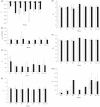Little impact of hatchery supplementation that uses native broodstock on the genetic structure and diversity of steelhead trout revealed by a large-scale spatio-temporal microsatellite survey
- PMID: 25568021
- PMCID: PMC3352543
- DOI: 10.1111/j.1752-4571.2011.00198.x
Little impact of hatchery supplementation that uses native broodstock on the genetic structure and diversity of steelhead trout revealed by a large-scale spatio-temporal microsatellite survey
Abstract
Artificial breeding programs initiated to enhance the size of animal populations are often motivated by the desire to increase harvest opportunities. The introduction of non-native genotypes, however, can have negative evolutionary impacts. These may be direct, such as introgressive hybridization, or indirect via competition. Less is known about the effects of stocking with native genotypes. We assayed variation at nine microsatellite loci in 902 steelhead trout (Oncorhynchus mykiss) from five rivers in British Columbia, Canada. These samples were collected over 58 years, a time period that spanned the initiation of native steelhead trout broodstock hatchery supplementation in these rivers. We detected no changes in estimates of effective population size, genetic variation or temporal genetic structure within any population, nor of altered genetic structure among them. Genetic interactions with nonmigratory O. mykiss, the use of substantial numbers of primarily native broodstock with an approximate 1:1 male-to-female ratio, and/or poor survival and reproductive success of hatchery fish may have minimized potential genetic changes. Although no genetic changes were detected, ecological effects of hatchery programs still may influence wild population productivity and abundance. Their effects await the design and implementation of a more comprehensive evaluation program.
Keywords: effective population size; gene flow; genetic drift; historical DNA samples; microsatellite DNA; native broodstock; salmonid; temporal analysis.
Figures

 symbol denotes the Kitimat River, study site for Heggenes et al. (2006).
symbol denotes the Kitimat River, study site for Heggenes et al. (2006).

Similar articles
-
Effective size of a wild salmonid population is greatly reduced by hatchery supplementation.Heredity (Edinb). 2012 Oct;109(4):254-60. doi: 10.1038/hdy.2012.39. Epub 2012 Jul 18. Heredity (Edinb). 2012. PMID: 22805657 Free PMC article.
-
Reproductive success of captive-bred steelhead trout in the wild: evaluation of three hatchery programs in the Hood river.Conserv Biol. 2007 Feb;21(1):181-90. doi: 10.1111/j.1523-1739.2006.00564.x. Conserv Biol. 2007. PMID: 17298524
-
Who are the missing parents? Grandparentage analysis identifies multiple sources of gene flow into a wild population.Mol Ecol. 2011 Mar;20(6):1263-76. doi: 10.1111/j.1365-294X.2010.04994.x. Epub 2011 Jan 19. Mol Ecol. 2011. PMID: 21244538
-
Difficulties for cost-benefit analysis in the 2020 environmental impact statement to recover the endangered wild salmon and steelhead in the Columbia River Basin.J Environ Manage. 2019 Sep 15;246:434-443. doi: 10.1016/j.jenvman.2019.05.099. Epub 2019 Jun 12. J Environ Manage. 2019. PMID: 31200178 Review.
-
The Italian Alpine and Subalpine trouts: Taxonomy, Evolution, and Conservation.Biology (Basel). 2022 Apr 11;11(4):576. doi: 10.3390/biology11040576. Biology (Basel). 2022. PMID: 35453775 Free PMC article. Review.
Cited by
-
Eco-evolutionary factors that influence its demographic oscillations in Prochilodus costatus (Actinopterygii: Characiformes) populations evidenced through a genetic spatial-temporal evaluation.Evol Appl. 2023 Apr 14;16(4):895-910. doi: 10.1111/eva.13544. eCollection 2023 Apr. Evol Appl. 2023. PMID: 37124086 Free PMC article.
-
Genetic assessment of a summer chum salmon metapopulation in recovery.Evol Appl. 2014 Feb;7(2):266-85. doi: 10.1111/eva.12118. Epub 2013 Nov 25. Evol Appl. 2014. PMID: 24567747 Free PMC article.
-
Source-sink estimates of genetic introgression show influence of hatchery strays on wild chum salmon populations in Prince William Sound, Alaska.PLoS One. 2013 Dec 13;8(12):e81916. doi: 10.1371/journal.pone.0081916. eCollection 2013. PLoS One. 2013. PMID: 24349150 Free PMC article.
-
Reduced fitness of Atlantic salmon released in the wild after one generation of captive breeding.Evol Appl. 2013 Apr;6(3):472-85. doi: 10.1111/eva.12028. Epub 2012 Nov 22. Evol Appl. 2013. PMID: 23745139 Free PMC article.
-
Genetic monitoring and complex population dynamics: insights from a 12-year study of the Rio Grande silvery minnow.Evol Appl. 2012 Sep;5(6):553-74. doi: 10.1111/j.1752-4571.2011.00235.x. Epub 2012 Jan 12. Evol Appl. 2012. PMID: 23028397 Free PMC article.
References
-
- Adkison MD. Population differentiation in Pacific salmon: local adaptation, genetic drift, or the environment? Canadian Journal of Fisheries and Aquatic Sciences. 1995;52:2762–2777.
-
- Ahrens R. The Status of Steelhead Trout (Oncorhynchus mykiss) in British Columbia. Vancouver, BC: Draft report prepared for the Pacific Fisheries Resource Conservation Council; 2004.
-
- Allendorf FW, England PR, Luikart G, Ritchie PA, Ryman N. Genetic effects of harvest on wild animal populations. Trends in Ecology and Evolution. 2008;23:327–337. - PubMed
-
- Araki H, Schmid C. Is hatchery stocking a help or harm? Evidence, limitations and future directions in ecological and genetic surveys. Aquaculture. 2010;308:S2–S11.
-
- Araki H, Cooper B, Blouin MS. Genetic effects of captive breeding cause a rapid, cumulative fitness decline in the wild. Science. 2007a;318:100–103. - PubMed
LinkOut - more resources
Full Text Sources
Other Literature Sources
Molecular Biology Databases

